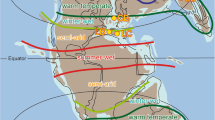Abstract
I tried to identify and assess the C reservoirs in the pedosphere with C-source-sink-relations whereever it seemed possible and pointing to the poorly known rather enigmatic remainder. A special endeavor focussed on the chances and limitations of applying radiocarbon dating and stable isotope δ13C measuring techniques.
Similar content being viewed by others
References
Aselmann,I., Crutzen, P.J.:1990, A Global inventory of wetland distribution and seasonality, net primary productivity and estimated methane emissions. in:Soils and the Greenhouse Effect, (Ed.A. F. Bouwman), Wiley, pp. 441–449.
Armentano, T.V. (Ed.): 1980, The role of organic soils in the world carbon cycle, CONF. 7905135, United States Department of Energy, Washington D.C.
Batjes, N.H.,Bridges, E.M.: 1992, World Inventory of Soil Emissions. ISRIC, WISE Report 1, p.132, Wageningen.
Becker-Heidmann, P.: 1989, Die Tiefenfunktionen der natürlichen Kohlenstoff-Isotopengehalte von dünnschichtweise beprobten Parabraunerden und ihre Relation zur Dynamik der organischen Substanz in diesen Böden. (Dissertation), Hamburger Bodenkundliehe Arbeiten,Vol 13,1–228.
Becker-Heidmann,P.:1990, Carbon fluxes in important soil classes, with emphasis on lessivé soils and on soil of the terrestrial, of the hydromorphic and temporarily submerged environment. Terminal Report to GTZ (contract 72.7866.6-01.400/1420), pp. 1–177.
Berner, R.A.: Atmospheric carbon dioxide levels over Phanerozoic time, Science 249, pp. 1382–1386.
Budyko, M.J., Ronov, A.B., Yanshin, A.L.: 1987, History of the Earth Atmosphere,p. 80, Springer, Berlin.
Driessen,P.M., Dudal, R.:1989 Lecture notes on the geography, formation, properties and use of the major soils of the world. Agricultural University Wageningen & Katholieke Universiteit Leuven, p.1–296.
Esser, G.:1990, Modelling global terrestrial sources and sinks of CO2 with special reference to soil organic matter. In: Soils and the Greenhouse Effect, (Ed. A.F.Bouwman), Wiley, pp. 247–263.
FAO,World Resources Reports: 1991, Vol.66, Food and Agricultural Organization of the United Nations,Rome, p.10.
Graß, H., Klingholz, R.:1990, Wir Klimamacher, p.70, S.Fischer Publ. Frankfurt.
Lovelock,J.E.;1979, 1978, Gaia, p.39, Oxford University Press.
Lovelock, J.E.: 1988, The Ages of Gaia, p. 84, W.W.Norton & Co, London, N.Y.
Lovelock, J.E.: 1991, Healing Gaia, p.23, Harmony Books, N.Y.
Houtermans, J., Suess, H.E., Munk, W.: 1967, Effect of industrial fuel combustion on the carbon-14 level of atmospheric CO2. In: Radioactive Dating and Methods of Low Level Counting, Vienna, IAEA, pp. 57–68.
Martin, A., Mariotti, A., Balesdent, B., Lavelle, P.,Vuattoux R.:1990, Estimate of organic matter turnover rate in a savanna soil by 13C natural abundance measurements. Soil Biol.Biochem. Vol. 22, No.4, pp.517–523.
MooreIII, B.M.P., Gildea, L.J., Vorosmarty plus five other contributors: 1989, Biogeochemical cycles. In: Global Ecology Towards a Science of the Biosphere (Eds. M.B. Rambler, L. Margulis, R. Fester). Academic Press, Boston, pp. 113–141.
Roeloffzen, J.E., Mook, W.G., Keeling, C.D.: 1990, Trends and variations in stable carbon isotopes of atmospheric carbon dioxide. Proc. IAEA/FAO-Intern. Sympos. on the Use of Stable Isotopes in Plant Nutrition, Soil Fertility and Environmental Studies. IAEA-SM-313, pp.1–24.
Scharpenseel, H.W., Schiffmann, H., Hintze, B.: 1984, Hamburg University Radiocarbon Dates III, Radiocarbon. (listed C-14 dates of Chinchilla-, Paget-, Gabbinbar-, Beechmont-Profiles, samples by Dr. Hubble, Australia.
Scharpenseel, H.W., Becker-Heidmann, P.: 1992, The dilemma of conflicting interests between CO2.′ s and CH4 ′s IR trapping capacity and role, in case of CO2 even as limiting factor for plant growth. Proceedings of “Global Warming, A Call for International Coordination”, in World Resource Review, Chicago, April 1992.
Scharpenseel, H.W., Becker-Heidmann, P.:1993, Carbon storage by grassland soils in different climate zones as revealed by carbon-14 dating. Paper 81+1, Proceedings of International Grassland Congress, February 1993, Palmerston North, N.Z. and Rockhampton, Australia.
Schlesinger, W.H.: 1985, The formation of caliche is soils of the Mojave desert, California. Geochim. Cosmochim. Acta,Vol 49, pp 57–66.
Schlesinger, W.H., Melack, J.M.:1981, Transport of organic carbon in the world rivers. Tellus, Vol 33, pp.172–187.
Tamers, M.A., Balke, K.D., Scharpenseel, H.W.: 1968, Untersuchungen zur Fließ- geschwindigkeit des Grundwassers durch Bestimmung der Radiokohlenstoff- und Tritiumaktivität. Zeitschr. Kulturtechnik, Flurbereinigung, Vol 9, p.364. (Curve in later years extended).
Whittaker, R.H., Likens, G.E.: 1973, The primary production of the biosphere. Human Ecology Vol 1, pp.299–369.
Author information
Authors and Affiliations
Rights and permissions
About this article
Cite this article
Scharpenseel, H.W. Major carbon reservoirs of the pedosphere; source - sink relations; potential of D14C and δ13C as supporting methodologies. Water Air Soil Pollut 70, 431–442 (1993). https://doi.org/10.1007/BF01105014
Issue Date:
DOI: https://doi.org/10.1007/BF01105014




